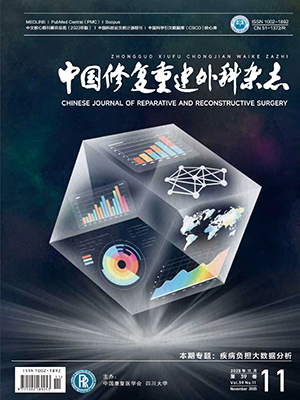Objective To investigate the effect of notochordal cells (NCs) conditioned medium (NCCM) on the
prol iferation and differentiation of bone marrow mesenchymal stem cells (BMSCs). Methods NCs and BMSCs were
isolated from the thoracolumbar intervertebral disc and the femurs of 4-week-old Japanese white rabbits, respectively. NCs
were cultured with DMEM/F12 medium containing 15% FBS for 5 days to prepare NCCM. The experiment consisted of
2 groups: BMSCs were cultured with NCCM in experimental group and with DMEM/F12 medium containing 15% FBS
in control group. The prol iferation of BMSCs was assessed by cell counting kit-8 at 1, 3, 5, 7, 9, and 14 days after culture;
the expression of proteoglycan and collagen type II were determined by immunofluorescence and real-time fluorescent
quantitative PCR at 7 and 14 days after culture. Results NCs and BMSCs were successfully isloated. At 5, 7, 9, and 14
days, the number of BMSCs in the experimental group was significantly more than those in the control group (P lt; 0.05).
At 7 and 14 days, there was no expression or less expression of proteoglycan and collagen type II in the control group;
however, there was a lot of expression of proteoglycan and collagen type II in the experimental group, and the expressions
were higher at 14 days than at 7 days. At 7 and 14 days after culture, the mRNA expressions of proteoglycan and collagen
type II were significantly higher in the experimental group than in the control group (P lt; 0.05), and at 14 days than at 7
days in the experimental group (P lt; 0.05). Conclusion NCCM can promote the prol iferation and the differentiation of
BMSCs into chondroyte-like cells, which provides the basis for NCs and BMSCs as seed cells in the treatment of degenerative
disc disease.
Citation: MA Kaige,SHAO Zengwu,WANG Baichuan,ZHANG Yannan,YANG Shuhua,LIU Tao.. PROMOTION EFFECT OF NOTOCHORDAL CELLS CONDITIONED MEDIUM ON PROLIFERATION ANDDIFFERENTIATION OF BONE MARROW MESENCHYMAL STEM CELLS/. Chinese Journal of Reparative and Reconstructive Surgery, 2012, 26(5): 601-606. doi: Copy
Copyright ? the editorial department of Chinese Journal of Reparative and Reconstructive Surgery of West China Medical Publisher. All rights reserved




